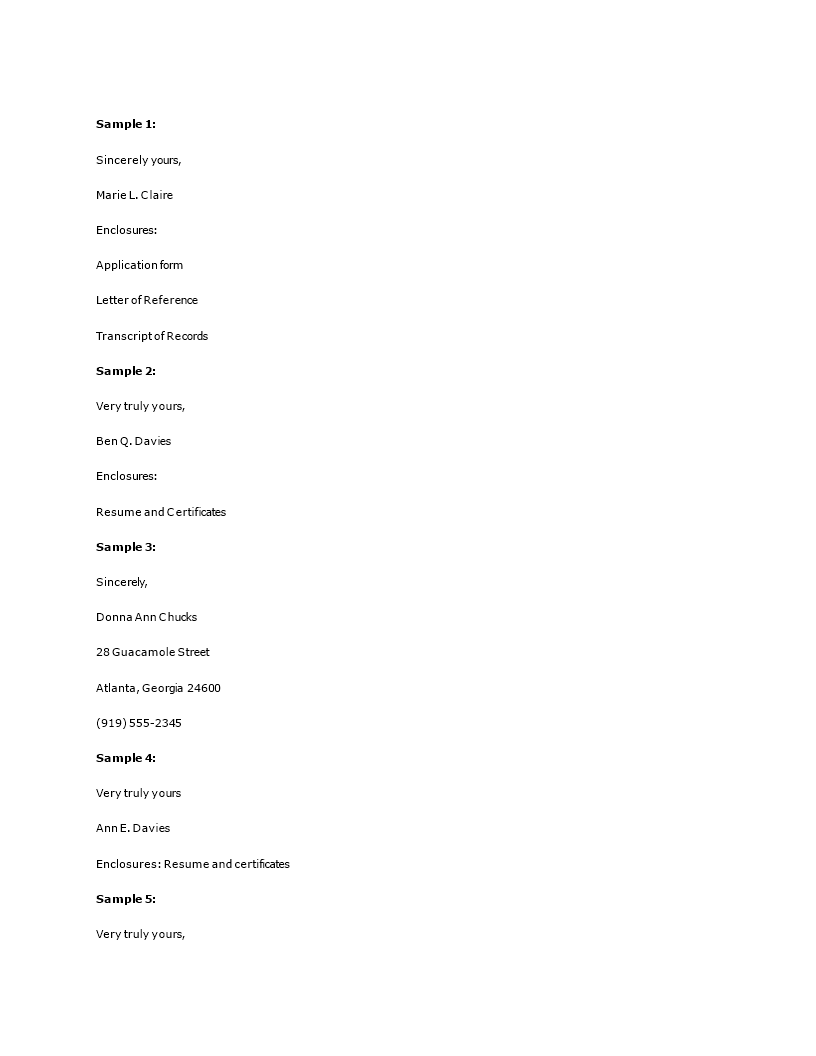Cover Letter Enclosure
Save, fill-In The Blanks, Print, Done!

Download Cover Letter Enclosure
Microsoft Word (.docx)Or select the format you want and we convert it for you for free:
- This Document Has Been Certified by a Professional
- 100% customizable
- This is a digital download (11.92 kB)
- Language: English
- We recommend downloading this file onto your computer.
What are suitable cover letter enclosures? What is the best way to write an enclosure in a letter? Our cover letter template includes sections for enclosures, such as a resume, portfolio, or other documents. Just fill in the information and you'll be ready to submit your cover letter! Download this list with sample cover letter enclosures now!
A cover letter for enclosures is a type of cover letter that you write when you are sending additional documents or materials alongside your job application. These enclosures could include your resume, a list of references, academic transcripts, certificates, or any other relevant documents that support your application. The cover letter for enclosures serves as a brief introduction to these additional materials and provides context for the recipient, typically an employer or hiring manager.
Here's a brief overview of how to structure and write a cover letter for enclosures:
- Header:
- Include your name, address, phone number, and email address at the top of the cover letter, followed by the date.
- Recipient's Information:
- Include the name and address of the person or organization receiving your application. If you have a specific contact person, address the letter to them. If not, use a general salutation like "Dear Hiring Manager."
- Opening Paragraph:
- Begin with a clear statement of the position you are applying for and where you found the job posting. Mention your interest in the position and briefly explain why you are a suitable candidate.
- Body Paragraph(s):
- Provide a concise overview of your qualifications and key skills relevant to the job. Highlight specific experiences or achievements that demonstrate your suitability for the position.
- Closing Paragraph:
- Express your enthusiasm for the position and your interest in further discussing your qualifications in an interview.
- Provide your contact information and indicate your availability for an interview or any additional information the recipient may need.
- Thank the recipient for considering your application.
- Complimentary Close:
- Use a professional closing, such as "Sincerely" or "Best regards."
- Signature:
- Sign your cover letter if you are sending a printed copy.
Remember to tailor your cover letter to the specific job and company you are applying to. Use this type of cover letter to draw attention to the supporting documents you are enclosing and to provide a cohesive application package.
These cover letter enclosures are easy to customize and help you to craft your cover letter.
Fast, safe, easy!
DISCLAIMER
Nothing on this site shall be considered legal advice and no attorney-client relationship is established.
Leave a Reply. If you have any questions or remarks, feel free to post them below.
How To Write An Appealing Cover Letter?
How to write the perfect cover letter? We provide the best professional, formal and basic letter of cover templates for you, which you can send together with for example your: Resume, Quotation, Memo, Contract, etc.
Read moreRelated templates
Latest templates
Latest topics
- Excel Templates
Where do I find templates for Excel? How do I create a template in Excel? Check these editable and printable Excel Templates and download them directly! - GDPR Compliance Templates
What do you need to become GDPR compliant? Are you looking for useful GDPR document templates to make you compliant? All these compliance documents will be available to download instantly... - Google Docs Templates
How to create documents in Google Docs? We provide Google Docs compatible template and these are the reasons why it's useful to work with Google Docs... - IT Security Standards Kit
What are IT Security Standards? Check out our collection of this newly updated IT Security Kit Standard templates, including policies, controls, processes, checklists, procedures and other documents. - Letter Format
How to format a letter? Here is a brief overview of common letter formats and templates in USA and UK and get inspirited immediately!
cheese

